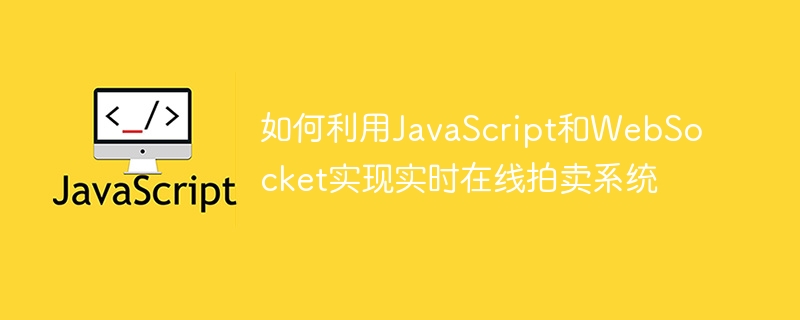Home >Web Front-end >JS Tutorial >How to implement a real-time online auction system using JavaScript and WebSocket
How to implement a real-time online auction system using JavaScript and WebSocket
- 王林Original
- 2023-12-18 13:50:051272browse

How to use JavaScript and WebSocket to implement a real-time online auction system
Introduction:
With the rapid development of the Internet, more and more traditional industries are beginning to rely on the Internet The platform undergoes transformation and upgrading. As a new business model, online auction not only facilitates transactions between buyers and sellers, but also provides more flexible and diverse auction methods. This article will introduce how to use JavaScript and WebSocket technology to build a real-time online auction system.
1. Introduction to WebSocket:
WebSocket is a protocol in the HTML5 specification. It provides a full-duplex communication method and can establish a persistent connection between the browser and the server. Compared with traditional HTTP requests, WebSocket is more suitable for real-time communication and can push data to the client in real time, thereby improving user experience.
2. Implementation steps:
-
Front-end interface design:
In the front-end interface, you need to design an auction room page to display auction item information and real-time Bidding situation. You can use HTML, CSS and JavaScript to implement this interface, and add a table to the interface to display bidding records.<!DOCTYPE html> <html> <head> <title>实时在线拍卖系统</title> <script src="https://cdnjs.cloudflare.com/ajax/libs/jquery/3.6.0/jquery.min.js"></script> <script src="app.js"></script> </head> <body> <h1>实时在线拍卖系统</h1> <table id="auctionTable"> <thead> <tr> <th>竞拍人</th> <th>竞拍价格</th> <th>竞拍时间</th> </tr> </thead> <tbody> </tbody> </table> </body> </html> -
Back-end server construction:
The back-end server can be built using Node.js. The advantage of using Node.js is that you can use the same language (JavaScript) to develop front-end and back-end code, which is more convenient when interacting with the front-end and back-end. Listen to the client's connection request through the WebSocket server and send the real-time auction data to the client.const WebSocket = require('ws'); const wss = new WebSocket.Server({ port: 8080 }); wss.on('connection', (ws) => { // 处理客户端连接请求 ws.on('message', (message) => { // 处理客户端的消息 }); ws.send('连接成功!'); }); // 发送拍卖数据给客户端 function sendAuctionData(data) { wss.clients.forEach((client) => { if (client.readyState === WebSocket.OPEN) { client.send(data); } }); } -
WebSocket message processing:
In the front-end page, use JavaScript to process WebSocket connections and messages. When a user bids, the front-end sends the bidding information to the back-end and displays the information on the auction room page in real time.const socket = new WebSocket('ws://localhost:8080'); socket.onmessage = function(event) { const auctionData = JSON.parse(event.data); // 更新拍卖室界面上的竞价记录 const tableRow = document.createElement('tr'); tableRow.innerHTML = ` <td>${auctionData.bidder}</td> <td>${auctionData.price}</td> <td>${auctionData.time}</td> `; document.querySelector('#auctionTable tbody').appendChild(tableRow); } function makeBid(bidder, price, time) { const auctionData = { bidder, price, time }; socket.send(JSON.stringify(auctionData)); } -
Improve the bidding logic:
In the back-end server, the bidding information sent by the client can be processed according to the bidding logic, calculate the highest price and send the latest bidding information To all online clients. The following is a simple bidding logic example:let highestPrice = 0; let highestBidder = ''; ws.on('message', (message) => { const auctionData = JSON.parse(message); const { bidder, price, time } = auctionData; if (price > highestPrice) { highestPrice = price; highestBidder = bidder; const newAuctionData = { bidder: highestBidder, price: highestPrice, time }; sendAuctionData(JSON.stringify(newAuctionData)); } });
Summary:
By utilizing JavaScript and WebSocket technology, we can implement a real-time online auction system. The system can provide real-time bidding record display, allowing sellers and buyers to conduct auction transactions more conveniently. Of course, the above examples only show the basic implementation ideas, and actual applications need to be customized according to specific needs. I hope this article helps you build a real-time online auction system.
The above is the detailed content of How to implement a real-time online auction system using JavaScript and WebSocket. For more information, please follow other related articles on the PHP Chinese website!

